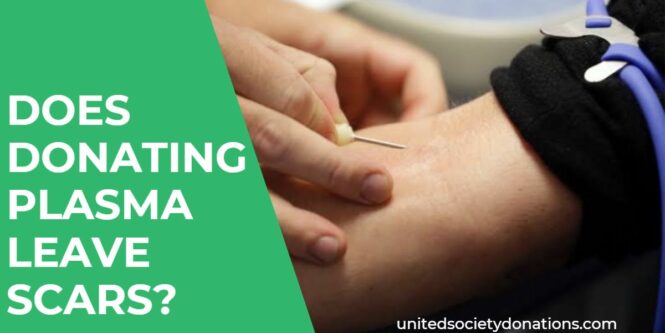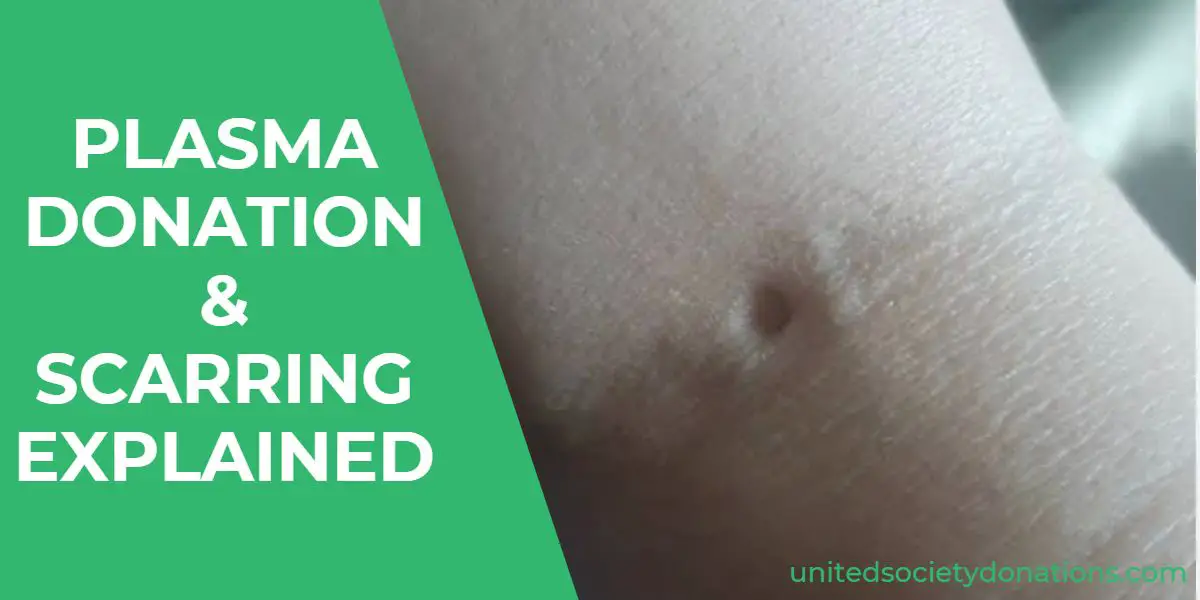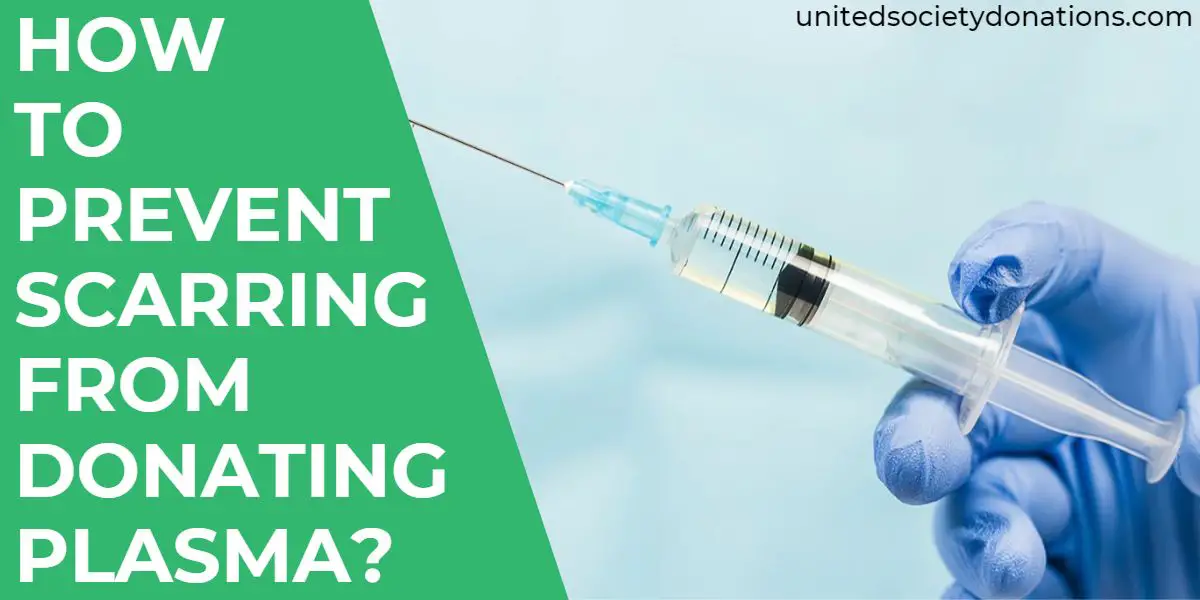
Doing anything for the first time can get scary. But it gets even scarier when you believe that there is a potential for it to hurt you. Nobody wants to get hurt!
As a first-timer trying to help others by donating your plasma, it’s completely understandable if your fear of getting hurt or scarred in the process clouds your charitable vision.
But does donating plasma leave scars on your body, or are you just worried about nothing?
Does Donating Plasma Leave Scars?
Yes, plasma donation can potentially result in scarring. However, the likelihood of scarring depends on various factors, such as the person’s skin type and the technique used for the donation. While some mild scarring may occur, it is typically minimal and not noticeable.

If you take any type of antidepressant, you should read this article on Can You Donate Plasma On Antidepressants?
Understanding The Plasma Donation Process And Its Relations To Scarring
Plasma donation is when blood is taken from a person and the plasma is separated and collected. The rest of the blood is then returned to the person’s body.
During this process, a needle is inserted into a vein in the arm and this can sometimes lead to scarring.
This scarring can occur when the needle used to draw blood is larger than the needle used for blood donations which can cause the underlying tissue to tear.
People with fairer skin or who are prone to scarring may have a higher chance of getting a scar.
Taking good care of the needle site can help reduce the chance of scarring and ensure proper healing.
If you are donating plasma for money, you should read this post on plasma donation first time bonus.
How To Prevent Scarring From Donating Plasma

Follow these steps to prevent scarring from donating plasma:
- Keep the needle insertion site clean: Wash the area with soap and water before and after the donation and cover it with a clean, dry bandage.
- Avoid excessive movement: Try to keep your arm still during the donation process to minimize the risk of bruising and irritation.
- Use a high-quality bandage: Use a sterile adhesive bandage or dressing to cover the needle insertion site.
- Apply pressure to the site: Apply pressure to the site after the needle is removed to reduce the risk of bruising and bleeding.
- Avoid picking at the site: Avoid touching or picking at the needle insertion site to reduce the risk of infection and scarring.
- Keep the area moisturized: Apply a thin layer of petroleum jelly or moisturizing cream to the site to prevent drying and cracking.
- Wait for proper healing: Allow the needle insertion site to fully heal before exposing it to harsh chemicals or excessive sun exposure.
- Choose a reputable plasma donation center: Look for one with a good reputation and strict protocols that use high-quality equipment for a safe and comfortable donation experience, reducing the risk of scarring.
Potential For Scars From Plasma Donation
The potential for scars from plasma donation depends on various factors such as the individual’s skin type and healing ability, the size of the needle used, and the technique used for the donation.
However, in most cases, any scarring from plasma donation is minimal and not noticeable.
If you are someone who goes to the gym regularly, check out this article on Does Donating Plasma Affect Muscle Growth?
What Factors Contribute To Scarring From Plasma Donation
These factors contribute to scarring from plasma donation:
- Size of the needle: Larger needles used during plasma donation can increase the risk of scarring.
- Bad Needle Insertion Technique: Improper needle insertion techniques, such as using excessive force or inserting the needle at an angle, can increase the risk of scarring.
- Healing process of individuals: Some people have a tendency to form scars more easily, which can make them more susceptible to scarring after plasma donation.
- Skin type: People with darker skin tones are more prone to scarring because of the quantity of collagen in their skin. This can make it harder for the skin to heal quickly.
- Infection: If you do not follow proper aftercare after the needle insertion, it can get infected and lead to scarring.
Plasma Donation Scar Removal – Treatment
Removing a scar gotten from a plasma donation is not a guaranteed process and it might be impossible to completely fade the scars, but, these treatment options can help to improve the appearance of scars:
- Give it time: In many cases, scars will fade naturally over time, especially if they are treated properly during the healing process.
- Keep your scar moisturized: Keeping the scar moisturized can help to improve the appearance of scars by keeping the skin hydrated and supple.
- Avoid the sun: Sun exposure can make scars more noticeable, so it is important to protect the skin from direct sunlight and wear sunblock with at least SPF 30.
- Use Silicone-based products: Silicone-based gels, creams, and sheets can help to reduce the appearance of scars by keeping the skin hydrated and improving its texture and appearance.
- Book a professional treatment: Laser therapy, micro-needling, and chemical peels can be effective ways to reduce the appearance of scars.
Frequently Asked Questions about Does donating plasma leave scars
These are the most Frequently Asked Questions about plasma donation and scarring:
Can Existing Scars from Plasma Donation Be Treated?
Existing scars from plasma donation can be treated with options like silicone sheets, creams, and injections, as well as minimally invasive procedures like laser therapy or microneedling.
Can you get rid of plasma scars?
It is not possible to completely eliminate plasma scars, but their look and feel can be improved and made less noticeable.
How Long Do Plasma Donation Marks Last?
The amount of time it takes for the marks to fade can range from several weeks to several months and sometimes even take several years.
Does Donating Plasma Leave a Hole?
Donating plasma does not leave a hole. The needle used for plasma donation is only inserted temporarily and the rest of the blood is returned to the body. Proper care of the needle insertion site can help it heal without any noticeable issues.
Conclusion
In conclusion, the question “Does Donating Plasma Leave Scars?” can be answered by saying that there is a possibility of scarring from plasma donation, but it depends on various factors such as the individual’s skin type and healing ability, the size of the needle used, and the technique used for the donation.
In most cases, any scarring is minimal and not noticeable. By taking proper care of the needle insertion site and choosing a reputable plasma donation center with strict protocols and high-quality equipment, the risk of scarring can be minimized.
